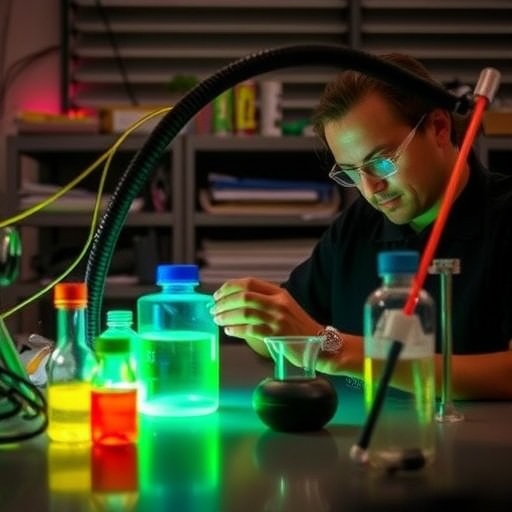In a groundbreaking development that challenges decades-old paradigms in photochemistry, an international team of researchers led by Queensland University of Technology (QUT) scientists has unveiled a novel understanding of how light interacts with molecules to trigger chemical reactions. This new perspective, detailed in the prestigious Journal of the American Chemical Society, reveals that the traditional view—where the efficiency of a photochemical reaction is dictated solely by the extent to which a molecule absorbs a particular wavelength of light—fails to capture the full complexity of molecular behavior under illumination.
For many years, the scientific community has operated under the assumption that the photoreactivity of a compound correlates directly with its absorptivity at specific wavelengths: the light that is most absorbed should be the most effective at initiating chemical transformations. However, the research team led by Distinguished Professor Christopher Barner-Kowollik, along with lead authors Dr. Joshua Carroll and Fred Pashley-Johnson, demonstrates that this relationship is far more nuanced than previously appreciated. Their work introduces the critical role of molecular microenvironments—minute, often neglected local surroundings around molecules—that can dramatically modulate their responsiveness to light.
At the heart of this phenomenon lies the ‘red-edge effect,’ a well-documented but underappreciated aspect of fluorescence science. The red-edge effect describes how molecules located in complex, heterogeneous environments can exhibit altered photophysical properties, such as prolonged excited-state lifetimes, when exposed to lower-energy, red-shifted light. By meticulously applying cutting-edge experimental techniques including fluorescence spectroscopy and photochemical action plots, the team confirmed that these microenvironmental influences extend beyond mere optical characteristics, fundamentally affecting photochemical reaction yields and pathways.
.adsslot_hR83q04CQk{ width:728px !important; height:90px !important; }
@media (max-width:1199px) { .adsslot_hR83q04CQk{ width:468px !important; height:60px !important; } }
@media (max-width:767px) { .adsslot_hR83q04CQk{ width:320px !important; height:50px !important; } }
ADVERTISEMENT
Fluorescence spectroscopy, a method that measures light absorption followed by emission at longer wavelengths, was employed to probe the subtle nuances of molecular excitation. This approach allowed the researchers to discern how variation in the immediate molecular surroundings affects both the absorption and subsequent reactivity of individual molecules. Complementing this, photochemical action plots quantitatively mapped the efficiency of photochemical reactions across different wavelengths, exposing discrepancies between absorptivity and reactivity that had long remained unexplained.
The implications of these findings are profound. By decoupling the assumption that high absorptivity guarantees high reactivity, the study opens new horizons for the precise control of photochemical processes. It suggests that by manipulating the chemical microenvironment—through solvent selection, molecular design, or even nanoscopic structuring—scientists can finely tune the reactivity of molecules, effectively customizing how light drives chemical transformations. This insight offers powerful new levers for fields ranging from photodynamic therapy to advanced manufacturing techniques such as 3D printing.
Photodynamic therapy, which relies on light-activated drugs to target diseased cells, could benefit immensely from these discoveries. By optimizing the microenvironment around therapeutic agents, treatment efficacy and specificity may increase, reducing side effects and improving patient outcomes. In polymer chemistry, the creation of materials with tailored properties may become more efficient as manipulation of photochemical reactivity at the molecular level enables custom polymer architectures and curing profiles, advancing both fundamental science and industrial applications.
Moreover, the study’s impact might extend to solar energy harvesting and organic synthesis. Light-harvesting materials, critical for efficient solar energy conversion, could be engineered to exploit microenvironment effects, maximizing photoreaction efficiencies under a broader spectrum of sunlight. Organic chemists may also find new strategies for inducing specific photochemical pathways previously inaccessible due to limitations imposed by traditional absorptivity-driven models.
The research collaboration spanned continents, involving not only the QUT Soft Matter Materials Group but also experts from Germany’s Karlsruhe Institute of Technology and the University of Freiburg. Their multidisciplinary approach combined expertise in photochemistry, spectroscopy, and molecular engineering to unravel these complex phenomena, underscoring the importance of cross-institutional and international efforts in addressing fundamental scientific challenges.
Professor Barner-Kowollik emphasized the transformative potential of controlling molecular microenvironments: “By tuning the surroundings of molecules—whether through the solvents they reside in or through deliberate molecular design—we are not just observing new photochemical behavior; we are actively harnessing it. This capacity to tailor light-molecule interactions introduces an unprecedented level of precision in photochemical science.”
Supported by grants from the Australian Research Council and the German Research Foundation, this breakthrough study stands to redefine how chemists conceptualize and deploy photochemical reactions. It challenges existing dogma, introduces a new conceptual framework for predicting reactivity, and paves the way for advanced applications across medicine, materials science, and renewable energy.
As the scientific community digests these findings, anticipation is growing for subsequent research that will delve deeper into how microenvironmental effects can be practically leveraged and engineered. The future of photochemistry now appears brighter, sharper, and more controllable than ever, affirming the endless capacity of light to drive innovation when its interaction with molecules is understood in full complexity.
For those interested in exploring the complete study, the full article titled Microenvironments as an Explanation for the Mismatch between Photochemical Absorptivity and Reactivity is available in the Journal of the American Chemical Society.
Subject of Research: Photochemistry focusing on the influence of molecular microenvironments on photochemical reactivity.
Article Title: Microenvironments as an Explanation for the Mismatch between Photochemical Absorptivity and Reactivity.
News Publication Date: July 16, 2025.
Web References:
https://pubs.acs.org/doi/10.1021/jacs.5c06961
Image Credits: Photo supplied by Queensland University of Technology (QUT).
Keywords
Photochemistry, molecular microenvironments, red-edge effect, fluorescence spectroscopy, photochemical reactivity, light-matter interaction, photodynamic therapy, polymer chemistry, solar energy, quantum chemistry.
Tags: advanced photochemistry principleschemical transformations and lightJournal of the American Chemical Society findingslight-molecule interactionsmolecular behavior under lightmolecular microenvironments in chemistryphotochemical reaction efficiencyphotochemistry breakthroughsphotoreactivity and absorptivity relationshipQueensland University of Technology researchred-edge effect in fluorescencescientific paradigm shifts in photochemistry





